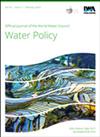Prediction of water resource carrying status based on the ‘three red lines’ water resource management policy in the coastal area of Jiangsu Province, China
IF 1.8
4区 环境科学与生态学
Q4 WATER RESOURCES
引用次数: 1
Abstract
Recently, the Chinese government has issued various policies to regulate water resource management. The ‘three red lines’ policy is one of the most important. To quantify the influence of the ‘three red lines’ policy on water resource carrying status (WRCS), analyze the shortcomings of the current water resource management and provide support for adjusting the direction of water resource management, we constructed a system dynamics model that considered ‘red line’ constraint feedback and simulated changes in WRCS characterization indicators from the period 2019 to 2040 in coastal cities of Jiangsu Province. The WRCS in Nantong city from 2019 to 2035 was medium and that from 2035 to 2040 was poor; that in Yancheng city from 2019 to 2037 was medium and that from 2038 to 2040 was poor; that in Lianyungang city from 2019 to 2036 was medium and that from 2037 to 2040 was poor. We then constructed three schemes with strategies to improve the WRCS. Compared with the initial scheme, Scheme I, involving further enhanced water resource utilization efficiency and reduced discharge of pollutants, improved the WRCS. Based on Scheme III, the economic scale can be expanded by increasing economic development at an appropriate speed, while the WRCS remains almost consistent with the initial scheme.基于“三条红线”水资源管理政策的江苏沿海地区水资源承载状况预测
最近,中国政府颁布了各种政策来规范水资源管理。“三条红线”政策是其中最重要的一条。为量化“三条红线”政策对水资源承载状况(WRCS)的影响,分析当前水资源管理存在的不足,为调整水资源管理方向提供支持,构建了考虑“三条红线”约束反馈的系统动力学模型,模拟了江苏省沿海城市2019 - 2040年水资源承载状况表征指标的变化。2019 - 2035年南通市WRCS为中等,2035 - 2040年为较差;盐城市2019 - 2037年为中等,2038 - 2040年为较差;连云港市2019年至2036年为中等水平,2037年至2040年为较差水平。然后,我们构建了三个方案,并提出了改进WRCS的策略。与初始方案相比,方案一进一步提高了水资源利用效率,减少了污染物排放,提高了WRCS。在方案三的基础上,以适当的速度增加经济发展,可以扩大经济规模,而WRCS与初始方案基本保持一致。
本文章由计算机程序翻译,如有差异,请以英文原文为准。
求助全文
约1分钟内获得全文
求助全文
来源期刊

Water Policy
环境科学-水资源
CiteScore
3.10
自引率
12.50%
发文量
81
审稿时长
6-12 weeks
期刊介绍:
Water Policy will publish reviews, research papers and progress reports in, among others, the following areas: financial, diplomatic, organizational, legal, administrative and research; organized by country, region or river basin. Water Policy also publishes reviews of books and grey literature.
 求助内容:
求助内容: 应助结果提醒方式:
应助结果提醒方式:


